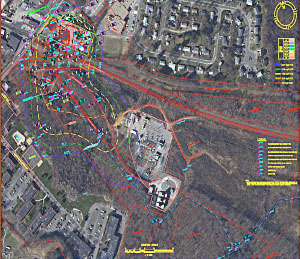Project Years: 2007-2011
RCRA / CERCLA Cleanup Process
FSE conducted site assessments, operated multiple remedial systems and oversaw remedial design activities at an active RCRA TSD facility with a historic chlorinated solvent groundwater plume. Investigation and remediation of this geologically complex plume is complicated by its downgradient migration beneath active railroad tracks, an inactive water supply aqueduct and extensive wetlands.
Design and Implementation of Remediation Strategies
FSE conducted ISCO bench scale treatability studies, ISCO field pilot studies and anaerobic bioremediation feasibility studies and evaluated the final remedy for the Site.
- ISCO pilot studies using sodium persulfate activated by hydrogen peroxide were successfully completed during 2009.
- Anaerobic bioremediation microcosm studies were performed. Quantitative Gene-Trac testing of groundwater was completed and identified the presence of naturally occurring Dhc, Dhb and vcrA bacteria in portions of the plume.
Geological, Geotechnical, Geothermal and Geophysical Investigations
FSE applied multiple approaches to delineate the lateral and vertical extent of LNAPL, DNAPL and dissolved phase VOCs. The field investigations included:
- Use of a membrane interface probe (MIP) and electrical conductivity (EC) probe with direct push technology to vertically profile to a depth of 55 feet and collect continuous groundwater data.
- Continuous soil sampling using direct push methods to construct detailed cross-sections that correlate VOC data with the heterogeneous interbedded silts, sands and clay strata.
The real-time MIP and EC data were evaluated in the field to determine additional survey locations and to establish well screen intervals.
Groundwater Investigation and Modeling / Soil and Sediment Investigation
FSE performed quarterly gauging of over 70 monitoring wells and 10 surface water locations. The quarterly groundwater investigations included:
- Low flow sampling of selected wells and analyses for VOCs and multiple bioremediation parameters.
- Specialized analyses for dissolved gases (methane, ethane, ethane, etc.) performed on selected wells to evaluate extent of anaerobic biodegradation.
- Preparation of groundwater contour maps, cross-sections, and evaluation of vertical flow gradients.
- Preparation of VOC concentration contour maps.
- Preparation of pH and ORP contour maps (using field data) to evaluate bioremediation methods.
Environmental Chemistry, Data Collection, Management and Interpretation
FS developed and maintained a single database that contained 15 years of historical gauging and sampling data, including low flow field chemistry data, for over 100 monitoring wells, recovery wells and surface water locations.
- Tables and graphs of VOCs vs. time for selected wells are updated and presented in both ppm and molar units.
- Data usability and validation assessments are performed on all data.
Human Health and Ecological Risk Assessment / Vapor Intrusion Investigation and Mitigation
Sub-slab soil gas sampling and indoor air sampling were completed at multiple residences to evaluate potential indoor air impacts from volatilization and migration of VOCs from the groundwater plume. The investigations determined there was no impact to a cross-gradient public school.
A sub-slab depressurization system (SSDS) was designed, installed, operated and optimized at one occupied residence. Regular indoor air sampling demonstrated the effectiveness of the installed system.
The scope of work for a detailed ecological risk assessment was developed.
Environmental Investigation and Cleanup with Local, State and Federal Regulatory Compliance
FSE managed the public involvement program for this project which includes quarterly meetings with multiple town boards and MassDEP, and public hearings with comment periods for each milestone report submittal.
Optimization, Operation and Maintenance of Remediation Systems
FSE conducted operation and maintenance of two pre-existing augmented aerobic bioremediation systems, one at the source area and one at a downgradient location. Each system used a combination of recovery wells and reinjection wells/galleys to achieve hydraulic containment, stimulate biodegradation, and reduce VOC concentrations.
Engineering Services during Construction of Remediation Projects
 FSE provided engineering oversight of the ISCO pilot study and managed the anaerobic bioremediation final remedy evaluation.
FSE provided engineering oversight of the ISCO pilot study and managed the anaerobic bioremediation final remedy evaluation.
